Deep learning system training scheme for 2-year prediction interval. Credit: Communication medicine (2024). DOI: 10.1038/s43856-024-00590-z
Researchers at King’s College London used anonymised NHS eye data from more than 100,000 people with diabetes to create an AI model that can accurately predict who is at high risk of developing sight-threatening diabetic retinopathy (DR) up to three years in advance.
The study is published in the journal Communication medicine.
DR is an eye disease that affects approximately 1 in 3 people with diabetes and is a leading cause of vision loss in working-age adults.
Anyone aged 12 or over diagnosed with diabetes on the NHS is encouraged to have an annual eye test for DR with the NHS Diabetes Eye Screening Programme (DESP), which screens around 3.2 million people at a cost of more than £85 million a year in England alone.
The AI model could be used as a tool to enable individualised DESP screening by predicting whether an individual is at low or high risk of developing sight-threatening DR in one year, two years or three years using fundus images, a capability the NHS does not currently have.
To develop the AI model, the researchers used more than 1.2 million retinal images of people with diabetes from the South East London PED. To ensure the model was robust enough to perform accurately on a wide range of individuals, it was validated on a dataset of around 70,000 images from the INSIGHT health data research centre.
“This project demonstrates the enormous value of collecting, storing and sharing routinely collected clinical data. It also shows the way forward in terms of how AI could move from hype to tangible benefit for patients, subject to further clinical studies,” says Professor Timothy Jackson.
“It was a pleasure to work on this clinically focused project that leveraged the cross-disciplinary capabilities of King’s Faculty of Life Sciences and Medicine. Using artificial intelligence to predict the incidence of diabetic retinal disease offers enormous social and economic opportunities.”
“AI can modernize diabetes screening programs without sacrificing their current ability to prevent sight loss,” says Professor Christos Bergeles.
If implemented, individualised screening would reduce the workload for people at low risk of vision loss, while ensuring that those at high risk of vision loss are seen urgently. This approach could save the NHS millions of pounds and thousands of appointments each year.
More information:
Paul Nderitu et al., Prediction of emerging diabetic retinopathy and maculopathy at 1, 2 and 3 years using deep learning, Communication medicine (2024). DOI: 10.1038/s43856-024-00590-z
Provided by King’s College London
Quote:AI tool uses eye imaging datasets to optimize diabetes eye screening (2024, September 12) retrieved September 12, 2024 from
This document is subject to copyright. Apart from any fair dealing for the purpose of private study or research, no part may be reproduced without written permission. The content is provided for informational purposes only.



